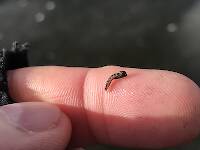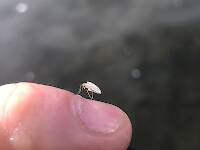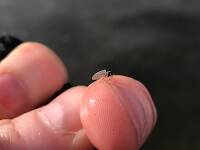
Hex Mayflies
Hexagenia limbata
The famous nocturnal Hex hatch of the Midwest (and a few other lucky locations) stirs to the surface mythically large brown trout that only touch streamers for the rest of the year.
Featured on the forum

Troutnut is a project started in 2003 by salmonid ecologist Jason "Troutnut" Neuswanger to help anglers and
fly tyers unabashedly embrace the entomological side of the sport. Learn more about Troutnut or
support the project for an enhanced experience here.
Deane on Jun 29, 2010June 29th, 2010, 5:41 pm EDT
I was fishing an evening hatch in late May of this year on the Driftwood Branch of Sinnemahoning Creek in Pennsylvania. There were Gray Foxes just finishing up for the day as the hatch weakened, Sulphers were coming off just at dark in growing numbers. The water temperature was around 68 degrees and the sun was bright, but behind the mountain and not directly on the water that I was fishing. A large mayfly had just hatched and flew right in front of me. I had seen this bug about five years ago and was not able to id it at that time either. I was able to catch it as it dipped back down. This mayfly has a reddish orange body with yellow segmentation when viewed from above. Turning it over, the belly is solid cream color. The wings are yellow with red veins and there are smaller wings, also yellow. There were two yellow tails about 1 1/2 times the length of the entire bug. The legs were also yellow but a creamy yellow.The thorax is yellow. I tied some to fish with on a size 12, 2X long hook, and it matched perfectly. I would be very appreciative for any help. I have looked all over the web and can't find a picture of this bug. I took a few with my camera, but I am a lot better fisherman that I am a photographer.
This is my first post. Thanks for the help.
Deane
This is my first post. Thanks for the help.
Deane
Deane
GONZO on Jun 30, 2010June 30th, 2010, 5:29 am EDT
Welcome! Sounds like Stenacron, Deane. Did it look something like these?
http://www.troutnut.com/specimen/618
http://www.troutnut.com/specimen/254
http://bugguide.net/node/view/416735/bgimage
(Keep in mind that the markings probably would not be as dark in your freshly hatched mayfly as they are in these "aged" specimens.)
http://www.troutnut.com/specimen/618
http://www.troutnut.com/specimen/254
http://bugguide.net/node/view/416735/bgimage
(Keep in mind that the markings probably would not be as dark in your freshly hatched mayfly as they are in these "aged" specimens.)
Deane on Jun 30, 2010June 30th, 2010, 7:04 am EDT
GONZO,
That is the bug. Thanks so much for taking the time to respond. Most cahills that I fish over are marked like small march browns. I know that the bug just hatched so it was definately a subimago. Are the cahill females marked differently than the males? I tie and fish size 14 cahills. This bug was a #12. The bugs in the pictures are all about an inch long which is about a 12, 2X long hook give or take a little. Maybe I should adjust my thinking and tie some longer cahills. Thanks again for the help.
Deane
That is the bug. Thanks so much for taking the time to respond. Most cahills that I fish over are marked like small march browns. I know that the bug just hatched so it was definately a subimago. Are the cahill females marked differently than the males? I tie and fish size 14 cahills. This bug was a #12. The bugs in the pictures are all about an inch long which is about a 12, 2X long hook give or take a little. Maybe I should adjust my thinking and tie some longer cahills. Thanks again for the help.
Deane
Deane
GONZO on Jun 30, 2010June 30th, 2010, 8:35 am EDT
Are the cahill females marked differently than the males?
http://www.troutnut.com/specimen/517
http://bugguide.net/node/view/393609/bgimage
(The last photo was probably taken closer to emergence.)
Quick Reply
Related Discussions
Topic
Replies
Last Reply
2
Jul 9, 2018
by Martinlf
by Martinlf
0
Oct 19, 2006
by GONZO
by GONZO





